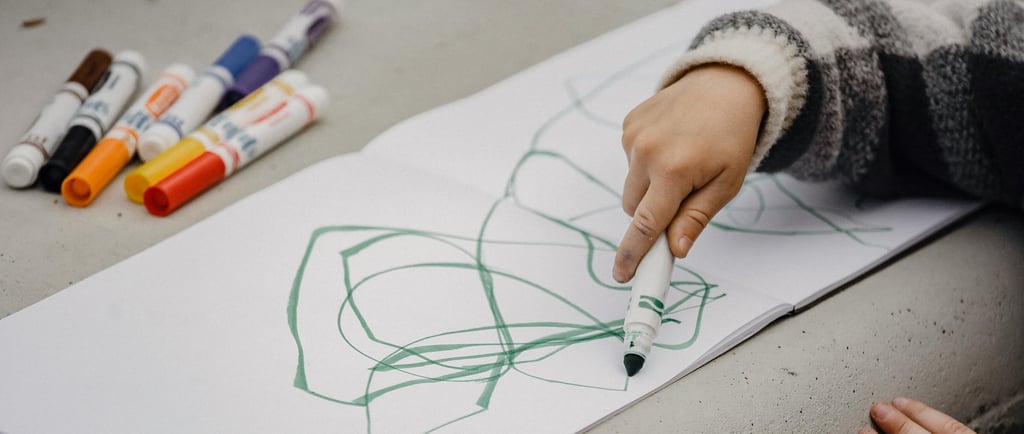From Scribbles to Masterpieces
The Power of Creative Expression
10/22/20243 min read


From Scribbles to Masterpieces: The Power of Creative Expression
Every child is an artist, whether they’re painting with vibrant colors, building elaborate Lego structures, or crafting stories with their toys. Creative expression isn’t just fun—it’s a powerful tool for development that helps children understand the world, express their emotions, and build important life skills. From scribbles on a piece of paper to a carefully constructed tower, these creative moments play a crucial role in shaping how children see themselves and the world around them.
Allowing children the freedom to create without judgment or expectation not only nurtures their imagination but also helps them develop problem-solving skills, emotional regulation, and self-confidence. And the best part? It doesn’t take expensive supplies or formal instruction to foster creativity—just an open mind and a willingness to explore.
The Benefits of Creative Expression
Creative expression plays a vital role in a child’s cognitive, emotional, and social development. When children engage in creative activities, they’re not just making something beautiful—they’re learning how to think critically, explore ideas, and solve problems. Whether it’s figuring out how to balance blocks to build a tall tower or deciding which colors to use in a painting, creativity encourages children to approach challenges with curiosity and persistence.
Creative activities also help children develop fine motor skills, especially in younger kids. Drawing, cutting with scissors, or molding clay all require control and coordination, which strengthens their hand-eye coordination and prepares them for more complex tasks in the future.
Beyond the cognitive and physical benefits, creative expression is a way for children to process and express their emotions. When words aren’t enough, art becomes a way to communicate feelings, frustrations, and joys. A child who’s had a tough day might draw a stormy sky, while another might create a bright, colorful scene that reflects their happiness. These artistic expressions are valuable emotional outlets, allowing children to process their experiences in a healthy and constructive way.
Encouraging Creativity at Home
Fostering creativity doesn’t require expensive art supplies or structured lessons. In fact, some of the best creative activities are spontaneous and open-ended. A stack of old magazines, some glue, and scissors can become the foundation for a collage. Cardboard boxes can transform into castles, spaceships, or pirate ships. Everyday objects become tools for creativity when children are given the freedom to explore.
As parents and caregivers, one of the most important things we can do is provide an environment where creativity is encouraged, not judged. Allow children to take the lead in their creative projects, and avoid giving instructions or corrections. The goal isn’t to create a perfect finished product—it’s to allow children to explore, make mistakes, and learn along the way.
Setting aside a dedicated space for creative activities can also make a big difference. Whether it’s a corner of the living room or a table in their bedroom, having a place where they can draw, build, or play with clay gives children the message that creativity is valued and important.
The Power of Play
Creative expression isn’t limited to art supplies—play is another powerful way for children to explore their imagination. When children engage in pretend play, they’re creating stories, inventing characters, and building worlds. This type of play helps children develop language skills, social understanding, and problem-solving abilities.
Playing dress-up, acting out stories with dolls or action figures, or even creating their own games all offer opportunities for creative expression. Encourage your child to take the lead in these activities, and be willing to join in when invited. When parents participate in pretend play, it not only strengthens the parent-child bond but also models the value of creativity and imagination.
Process Over Product
One of the key principles of creative expression is focusing on the process, not the product. Children’s art, writing, or building projects don’t need to look a certain way or meet adult standards of beauty. The value lies in the experience of creating—experimenting with materials, making decisions, and learning through trial and error.
When children feel that their creative efforts are valued for the process, they’re more likely to take risks, try new things, and develop resilience. They learn that it’s okay to make mistakes and that failure is part of the creative journey.
Creative expression is a gift that allows children to explore who they are and how they fit into the world. Whether it’s through art, play, music, or storytelling, these moments of creativity are shaping children’s minds and hearts. So the next time your child grabs a crayon or starts building a fort in the living room, remember that they’re not just playing—they’re learning, growing, and expressing themselves in ways that will last a lifetime.


